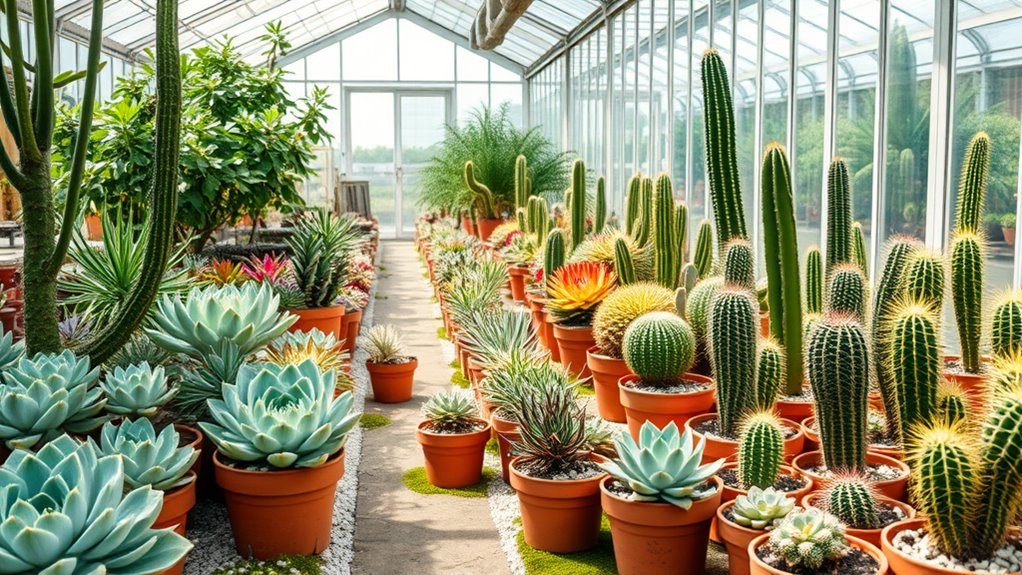To grow succulents and cacti successfully in a greenhouse, you should maintain a controlled environment with proper soil, watering, and light. Use well-draining soil mixes and water deeply only when the soil is dry, adjusting based on humidity and season. Keep an eye on temperature and light levels to prevent overwatering or root rot. Mastering these conditions helps your plants thrive—keep exploring, and you’ll discover the key to perfect greenhouse care.
Key Takeaways
- Maintain a controlled environment with proper humidity, temperature, and light to support succulent and cactus growth.
- Use well-draining soil mixes like cactus or succulent soil to prevent root rot.
- Adjust watering frequency seasonally, ensuring deep watering and soil drying between sessions.
- Monitor soil moisture regularly and modify watering routines based on plant signals and environmental conditions.
- Ensure adequate airflow and avoid overwatering to promote healthy root systems and prevent fungal issues.

Growing succulents and cacti in a greenhouse offers a controlled environment that helps these drought-tolerant plants thrive. When cultivating these plants indoors, paying close attention to your watering routines and soil mixtures is essential for their health and growth. Unlike traditional houseplants, succulents and cacti require less frequent watering, but consistency is key. You should aim to water deeply, then allow the soil to dry out completely before the next watering. Overwatering is a common mistake that can lead to root rot, so establishing a routine that aligns with the plant’s needs and the greenhouse’s humidity levels is crucial. During warmer months, you might find yourself watering once every week or two, but in cooler seasons, this frequency drops, sometimes to once a month. Monitoring your plants and adjusting your watering schedule accordingly ensures they don’t remain soggy, which is vital to their survival.
Equally important is selecting the right soil mixture. Succulents and cacti thrive in well-draining soil that prevents excess moisture from lingering around their roots. Standard potting soil isn’t suitable because it tends to retain too much water. Instead, you should use a specialized cactus or succulent mix, or create your own by combining coarse sand, perlite, or pumice with high-quality potting soil. This blend encourages quick drainage and aeration, reducing the risk of fungal infections and root rot. When filling your pots, ensure the soil is loose and not compacted, allowing roots to spread out freely and access oxygen. Regularly checking the soil’s moisture level with your finger or a moisture meter helps you stay ahead of potential problems, so you can adjust your watering routines before any issues develop. Understanding the importance of soil drainage can significantly improve plant health and longevity.
In a greenhouse setting, environmental factors like humidity, temperature, and light influence how often you water and how you prepare your soil. If your greenhouse tends to be more humid, you might need to water even less frequently, as moisture lingers longer in the soil. Conversely, in dry, sunny conditions, plants may require slightly more frequent watering, but still within the safe limits to prevent overwatering. The key is to observe your plants closely and adapt your routine based on their signals. Combining proper watering routines with the right soil mixtures creates an ideal environment for succulents and cacti, ensuring they stay healthy, vibrant, and resilient. With consistent care and attention, your greenhouse can become a lush oasis of drought-tolerant plants that flourish year-round.
Frequently Asked Questions
How Can I Prevent Pests in My Greenhouse Succulents?
To prevent pests in your greenhouse succulents, start by choosing pest-resistant plants and maintaining good hygiene. Regularly inspect your succulents and remove any dead leaves or debris that attract pests. Use natural pest control methods like neem oil or insecticidal soap to keep pests at bay. Ensuring proper airflow and not overwatering also helps prevent infestations. Consistent monitoring and proactive care will keep your succulents healthy and pest-free.
What Are the Best Watering Techniques for Cacti?
You should water your cacti sparingly, following a consistent watering schedule that allows the soil to dry out completely between waterings. Use proper drainage techniques, like well-draining soil and pots with drainage holes, to prevent water from sitting around the roots. During the growing season, water every 2-3 weeks, but cut back in winter. Always check soil moisture before watering to avoid overwatering and root rot.
How Do I Control Humidity Levels Inside the Greenhouse?
Think of controlling humidity like walking a tightrope—you need balance. To manage humidity levels, you’ll want to implement effective ventilation strategies like exhaust fans or open vents to prevent excess moisture. Regularly monitor humidity with a hygrometer and adjust ventilation accordingly. Using dehumidifiers can also help, especially during humid days. Staying proactive with humidity management guarantees your succulents and cacti stay healthy and thriving in the greenhouse environment.
Can Succulents Thrive in Low-Light Greenhouse Conditions?
Yes, succulents can thrive in low-light greenhouse conditions, but you’ll need to monitor their health closely. Low light can cause etiolation, making succulents leggy and weak. To maintain succulent health, place them where they get some indirect light or supplement with grow lights. Make certain of good air circulation and avoid overwatering, as these factors help prevent issues caused by insufficient light. With proper care, your succulents will stay healthy and vibrant.
What Soil Mixture Is Ideal for Different Succulent Species?
You should use a well-draining soil mixture tailored to each succulent species. A good soil composition includes coarse sand, perlite or pumice, and organic matter like potting soil. This guarantees proper drainage solutions, preventing root rot. For desert succulents, lean toward more mineral-rich mixes, while tropical varieties may need slightly richer soil. Adjust the components based on the specific needs of each succulent to promote healthy growth.
Conclusion
Growing succulents and cacti in a greenhouse is rewarding and manageable. Did you know that these plants can survive with minimal water, requiring up to 70% less than traditional houseplants? With proper care and the right environment, you’ll enjoy vibrant, low-maintenance greenery year-round. So, set up your greenhouse confidently, and watch your succulent and cactus collection thrive, adding beauty and resilience to your space effortlessly.








